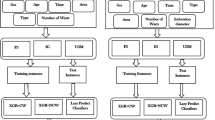Abstract
In clinical research, adequate use of gathered information to provide an intelligent framework to assist the doctors is a great challenge for the current biomedical research community. This study proposed a probabilistic deep neural network (PDNN) to select wart treatment method, where the layered structure of artificial neurons plays a crucial role in generating the optimal feature space. However, the probabilistic and thresholding technique is used to minimize the false negative and false positive instances. In the existing approaches, prediction accuracy and biasedness are major concerns in identifying the best wart treatment method. The benchmark dataset consists of 180 patients toward the selection of immunotherapy and cryotherapy treatment methods. Based on the feature descriptors about the wart, the baseline classifiers such as Naïve Bayes (NB), logistic regression and ensemble (LR), support vector machine (SVM), decision tree (DT), bagging, random forest (RF), and eXtreme Gradient Boosting (XGB) along with the developed PDNN was constructed by taking splitting ratio criteria into account. The standard statistical measures such as the measure of accuracy (MoA), error rate, sensitivity, specificity, and area under the curve (AUC) were considered to evaluate the predictive behavior. The proposed PDNN approach obtained promising results: moA, error rate, sensitivity, specificity, and measure of AUC as 0.9778, 0.0222, 0.9762, 0.9792, and 0.9818 while selecting immunotherapy and 0.9889, 0.0111, 1.0000, 0.9796, and 0.9970 in case of cryotherapy. The developed PDNN outperforms baseline classifiers and existing state-of-the-art wart treatment expert systems. The proposed model will improve the success rate and saves the diagnosing time. PDNN-based wart treatment identification system can be implemented in real time after consulting with a domain specialist.






Similar content being viewed by others
References
Al Aboud AM, Nigam PK. Wart (plantar, verruca vulgaris, verrucae). StatPearls [Internet]. 2020.
Abdar M, Wijayaningrum VN, Hussain S, Alizadehsani R, Plawiak P, Acharya UR, Makarenkov V. Iapso-airs: A novel improved machine learning-based system for wart disease treatment. J Med Syst. 2019;43(7):220.
Khozeimeh F, Alizadehsani R, Roshanzamir M, Khosravi A, Layegh P, Nahavandi S. An expert system for selecting wart treatment method. Comput Biol Med. 2017;81:167–75.
Ferroni P, Zanzotto FM, Scarpato N, Spila A, Fofi L, Egeo G, Rullo A, Palmirotta R, Barbanti P, Guadagni F. Machine learning approach to predict medication overuse in migraine patients. Comput Struct Biotechnol J. 2020;18:1487–96.
Akben SB. Predicting the success of wart treatment methods using decision tree based fuzzy informative images. Biocybernetics and Biomedical Engineering. 2018;38(4):819–27.
Ghiasi MM, Zendehboudi S. Decision tree-based methodology to select a proper approach for wart treatment. Comput Biol Med. 2019;108:400–9.
Jia W, Xia H, Jia L, Deng Y, Liu X. The selection of wart treatment method based on synthetic minority over-sampling technique and axiomatic fuzzy set theory. Biocybernetics and Biomedical Engineering. 2020;40(1):517–26.
Mishra A, Reddy US. Machine learning approach for wart treatment selection: prominence on performance assessment. Network Modeling Analysis in Health Informatics and Bioinformatics. 2020;9:1–14.
Dey N, Ashour AS, Fong SJ, Bhatt C. Healthcare data analytics and management. Academic Press, 2018.
Lan K, Wang D-T, Fong S, Liu L-S, Wong KK, Dey N. A survey of data mining and deep learning in bioinformatics. J Med Syst. 2018;42(8):1–20.
Mahmud M, Kaiser MS, McGinnity TM, Hussain A. Deep learning in mining biological data. Cogn Comput. 2021;13(1):1–33.
Rahman MM, Zhou Y, Wang S, Rogers J. Wart treatment decision support using support vector machine. International Journal of Intelligent Systems and Applications. 2020;12(1):1–11.
Ali MNY, Sarowar MG, Rahman ML, Chaki J, Dey N, Tavares JMR. Adam deep learning with som for human sentiment classification. International Journal of Ambient Computing and Intelligence (IJACI). 2019;10(3):92–116.
Putra MA, Setiawan NA, Wibirama S. Wart treatment method selection using adaboost with random forests as a weak learner. Communications in Science and Technology. 2018;3(2):52–6.
Jain R, Sawhney R, Mathur P. Feature selection for cryotherapy and immunotherapy treatment methods based on gravitational search algorithm. In 2018 International Conference on Current Trends towards Converging Technologies (ICCTCT). 2018:1–7.
Basarslan MS, Kayaalp F. A hybrid classification example in the diagnosis of skin disease with cryotherapy and immunotherapy treatment. In 2018 2nd International Symposium on Multidisciplinary Studies and Innovative Technologies (ISMSIT). 2018:1–5.
Degirmenci A, Karal O. Evaluation of kernel effects on svm classification in the success of wart treatment methods. American Journal of Engineering Research. 2018;7:238–44.
Akyol K, Karacı A, Gültepe Y. Study on prediction success of machine learning algorithms for wart treatment. In International Conference on Advanced Technologies, Computer Engineering and Science (ICATCES’18). 2018:186–8.
Junio Guimarães A, Vitor de Campos Souza P, Jonathan Silva Araújo V, Silva Rezende T, Souza Araújo V. Pruning fuzzy neural network applied to the construction of expert systems to aid in the diagnosis of the treatment of cryotherapy and immunotherapy. Big Data and Cognitive Computing. 2019;3(2):1–20.
Acknowledgements
Mr. Abinash Mishra would like to thank the Ministry of Human Resource and Development for providing the financial support (Grant number 405117002). Also, we would like to thank the Machine Learning and Data Analytics Lab, Department of Computer Applications, National Institute of Technology, Tiruchirappalli, for the infrastructure support.
Author information
Authors and Affiliations
Corresponding author
Ethics declarations
Ethical Approval
This article does not contain any studies with human participants or animals performed by any of the authors.
Conflicts of Interest
The authors declare that they have no conflict of interest.
Rights and permissions
About this article
Cite this article
Mishra, A., Uyyala, S.R. & A, V.R. A Novel Probabilistic-Based Deep Neural Network: Toward the Selection of Wart Treatment. Cogn Comput 14, 1643–1659 (2022). https://doi.org/10.1007/s12559-021-09882-1
Received:
Accepted:
Published:
Issue Date:
DOI: https://doi.org/10.1007/s12559-021-09882-1




